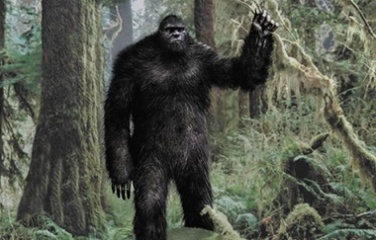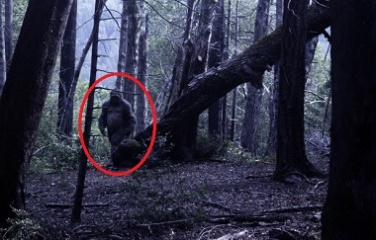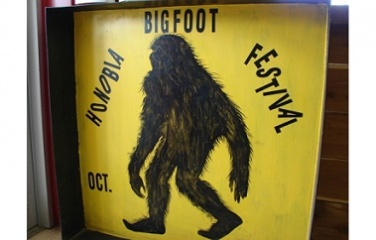In the woods you hear heavy footsteps pounding against the forest floor. Confused, you look for the source of the commotion and see a large figure darting through the trees. It appears to be coming towards a clearing directly in front of you. You turn on your flashlight just in time to see the creature glancing back at you as it continues to run through the forest.
What is Bigfoot?
Bigfoot is one of the oldest creatures to make its way into American mythology and was part of the folklore of indigenous cultures well before the first settlers arrived. The Native Americans had many names for large, ape-like giants that lived among their tribes or above the mountain tree line. When America was colonized (especially the western states) many of these stories came to the forefront and were shared by the regional tribes. It was then that the stories of Bigfoot became a common part of American folklore – though it would be much later before the beast was given a name.
Although Bigfoot is most commonly depicted as an American creature, there is folklore all over the world that suggests the creature is not unique to the Americas. In fact, every continent except for Antarctica has some sort of legend that tells of a Bigfoot-like creature.
The first sightings of Bigfoot among the indigenous tribes that inhabited the Americas before the colonists arrived are unknown, but the first stories of encounters of these creatures were recorded in Canada by J. W. Burns.
J. W. Burns was a teacher that spent many years as a teacher at the Chehalis Indian Reserve. This reservation is located about 60 miles away from Vancouver. While working on the reservation, he often heard whispers of stories regarding ‘wild men’ or ‘fathers of the forest.’ For many years, he pushed to learn more about who these strange people or creatures were, but was denied for fear that the colonists would laugh at their beliefs. This is likely because many of the stories of sightings of ape-like giants reported by Indians and colonists were from a great distance and were often simply written off as bear sightings. In addition to this, actual sightings were rare – it was much more common to simply find large tracks. Many of these track findings were often written off as belonging to bears or related creatures.
After three years of diligent searching, he finally found the information he was hoping to find – a tale of a close encounter with one of the giant beasts by Peter Williams – a Native who lived on the Chehalis Reserve. Peter told him a tale of a giant he encountered in the forest while hunting. He had almost mistaken the creature for a bear when it suddenly stood up and revealed itself to be a giant man covered in thick hair. The creature jumped from where it had been perched and started chasing Peter through the woods. It reportedly chased him all the way to his home, where it then pushed against the walls with its bare hands and caused significant damage to the property.
Peter Williams was not the only person living in the Chehalis Indian Reserve to report an encounter with these incredible giants. There were many encounters with these creatures during this period of time. The encounters took place for a period of two to three years before suddenly stopping. During these years, at least three different giants were sighted including at least one female giant. These reports were printed in many Vancouver newspapers as well as several magazines during the year 1929. At the time, it was said that the Natives who reported the stories believed these giants could still be living in a mountain range nearby. Though there were many names used to describe the creatures in these sightings, J.W. Burns reported them as being ‘Sasquatch’ and solidified this as the most common name for Bigfoot in Canada.
The next famous sighting of a giant creature would be in 1958. It was this sighting that would give us a name for the legendary forest giant; Bigfoot.
Although the 1958 reports of Bigfoot weren’t actually sightings, they were responsible for the name that was given to the creature. It was in this year that a man named Gerald Crew found a set of prints at a construction site in California that were obviously too big to be human, though they had very humanistic qualities. Gerald recruited a friend to make plaster molds of these footprints to use as evidence of their find.
The Crew story was quickly picked up in local newspapers. After being picked up by both the Humboldt Times and the Associated Press, the story was given credibility and even international recognition. Many years later, the find was said to be a hoax. When the brother of the man who ran the site died, the family came forward to say that their son had left the prints as a hoax. When the story was exposed as a hoax, many people also began to question the involvement of the editor of the Humboldt Times.
Despite the new information that showed the Crew story to be a hoax, the 1958 case continued to draw ‘Bigfoot’ hunters to the area and would be the case that solidified the name of the mysterious beast in history.
Since these first sightings, many people have come forward with their own Bigfoot stories. Unfortunately, many of these stories either lack physical evidence or were later proven to be hoaxes.
Characteristics
Physical Description
Although the evidence of Bigfoot’s existence continues to evade the spotlight, the stories of sightings surrounding this mysterious creature continue to describe the same figure.
According to those who have spotted Bigfoot, there are several key characteristics that keep it distinguished from other large creatures of the forest. One of the most important of these characteristics and features is the distinct gait of the creature. Bigfoot appears to be a bipedal creature (walks on two legs instead of four), but has a curious gait that suggests the creature has an anatomy that is significantly different from that of humans.
The creature is also known to leave behind impressive footprints. The largest Bigfoot prints that have been discovered are up to 24 inches in length and 8 inches in width. Details regarding the prints vary from source to source, though there have been a significant amount of print sightings that are said to contain claw marks. These prints are some of the most controversial as many believe the claw marks make them more likely to come from a bear than a giant.
Bigfoot is also know for its large stature. Bigfoot’s height varies largely from sighting to sighting, though most people believe the creature to be at least 6 feet in height with the possibility of reaching heights up to 10 feet. The female Bigfoot is typically significantly smaller than her male counterpart, though she is said to always stand much taller than the average human.
These creatures are often described as being covered in thick hair that is either black, red, or brown. This hair covers a large portion of their body, though there are areas that are more exposed. Witnesses who have gotten close to the Bigfoot have reported easily identifiable sex traits similar to those of humans.
Witnesses who get close enough to see distinct features of Bigfoot also report that the creature has a prominent forehead that is much larger than any human face. The top of the cranium is also shaped similarly to that of a primate.
Personality
The personality of the Bigfoot is difficult to distinguish since there have been very few encounters that lasted more than a few minutes and none of these encounters describe any sort of communication between the giants and the witnesses.
Most of what we know about Bigfoot’s personality comes from the stories passed down from indigenous cultures. There are several different variations of the personalities of the Bigfoot giants, as well as different names for the creatures depending who discovered them.
The majority of stories that talk about giant creatures seem to report that these beings don’t seem to be violent – though they do like their privacy. These creatures are often documented as stealing food from villages or salmon from fishermen’s nets. Some of the more docile creatures are also reported to have their own language. The Native tribes who see these giants also claim that they dislike white men and prefer to avoid them when possible.
There are, however, reports of giants who were much more aggressive. Some of these monsters were so fearsome that it was thought to be bad to say the name in case they heard it and came to take the offender away to be killed. Some of these aggressive beasts were also thought to have cannibalistic tendencies.
Famous Sightings
The 1958 Story
This is perhaps the most famous sighting of Bigfoot as it was the incident that led to the naming of the creature.
In 1958, Gerald Crew was working at a construction site in California when he stumbled across a huge set of footprints. The tracks were over 20 inches in length and left a significant impression in the ground. He recruited a friend to help him make plaster molds of the prints and show them to people in the community.
The story was quickly picked up by the Humboldt Times and the Associated Press which gave the story credibility and international attention. This is also how the name ‘Bigfoot’ came into being – a moniker for the large prints the creature left behind.
Eventually the story would be discovered as a hoax. In spite of this, it would be the biggest story to draw Bigfoot hunters to California in search of the creature.
The Patterson-Gimlin Film
In 1967, a film that would serve as one of the biggest pieces of evidence for Bigfoot believers was capture – the Patterson-GImlin film. This video shows a creature that is supposedly Bigfoot walking in the forest.
One of the biggest reasons people believe the film is actual evidence of Bigfoot is the way the creature walked. One of the videographers claimed that the film was analyzed by a special effects department in a professional film studio and the staff concluded that the video would have been nearly impossible to fake.
Since the film, there have been people who have come forward and claimed to have worn a suit to fake the film. More questions have arisen for the filmmakers because their claims about how big the creature was and other details of the story have changed over time. Because of this, many people believe the Patterson-Gimlin film was likely another fake.
Explanation of the Myth
Despite the large number of hoaxes on record and the lack of physical evidence to support the possibility of giants living among us, many continue to believe in the Bigfoot story. This is partially because of the frequency with which they appear in our historical records and partially because of a natural desire to believe in something larger than life.
There are many theories for the origins of the Bigfoot myths. With their widespread presence throughout the world, some would say they serve as evidence of a creature that does (or did) exist. However, there are others who would say the large number of Bigfoot-like myths were bound to be created at some point. Many anthropologists believe these myths were created out of a need to express a larger than life being that helped to humble people.
Other people think that Bigfoot could have simply been a way to scare people into having good behavior. This is especially evident in the stiyaha and skoocooms versions of Bigfoot who have incredibly violent and cannibalistic tendencies.
There are also those who believe Bigfoot legends could have come from groups of primates and hominidaes who managed to live past the extinction of the rest of their kind. There are two different species that are used often with this theory.
The most popular example of a primate that managed to live past the extinction of its species is the Gigantopithecus. This creature was originally found in Asia, but due to its proximity to the Bering Land Bridge, it is hypothesized that the creature could have migrated to the Americas through this route. Unfortunately, the only fossils of the Gigantopithecus that have been recovered are teeth and parts of the mandibles. This leaves a lot of uncertainty regarding the rest of the composition of the animal. Perhaps most critically, we don’t know if the creature was bipedal or quadrupedal.
Another creature that is commonly proposed as a Bigfoot candidate is the Paranthropus. This creature is known to have a crested skull (characteristic of Bigfoot) and as being a bipedal creature. However, many people disagree with their potential of being the infamous Bigfoot because their fossils have only been found in Africa.
Bigfoot






No comments:
Post a Comment